![]()
![]()
![]()
Use LEFT and RIGHT arrow keys to navigate between flashcards;
Use UP and DOWN arrow keys to flip the card;
H to show hint;
A reads text to speech;
56 Cards in this Set
- Front
- Back
|
Are gravitational and electric fields similar or not? Why? |
Gravitational and Electric fields are very similar. This is because most of the equations we have for gravitational and electric fields are basically the same for both of them, but just slightly tweaked. |
|
|
Define a Field. |
Field - an area of space where a mass/charge will feel a force. |
|
|
1) If you put a mass in a gravitational field, what will it feel? 2) If you put a charge in an electric field, what will it feel? |
1) It will feel a force 2) It will feel a force |
|
|
Planets can have gravitational fields. Let's say we have a planet, and you put a mass near the planet so it's within the planet's gravitational field.
Draw a sketch of this and label any parts of importance. |
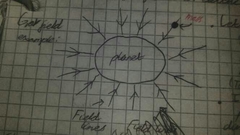
|
|
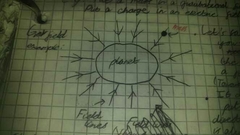
If you put a mass within the planet's gravitational field, what will happen to the mass? What is causing this? In what direction does this thing affecting the mass act? Will this thing always act towards the same place, despite where the mass is put within the gravitational field? Why? |
The mass will be pulled towards the planet's centre by a force. The force acting on the mass acts towards the centre of the planet The force acting on the mass will always be towards the centre of the planet, despite where the mass is within the gravitational field because gravity is always ATTRACTIVE. |
|
|
For an electric field: Let's say we have a proton. Draw a proton, and the direction in which it's electric field lines are. Are a proton's electric field lines always in this direction? Field lines for an electron are in what direction? |

Outwards. Proton, always. Field lines for an electron are inwards. |
|
|
1) If we put an electron close to a proton, what will happen? 2) If we put a proton close to another proton, what would happen? 3) Despite this, in what direction are the field lines of a proton? |
1) proton near electron, they attract to each other 2) proton near proton, they repel from each other. 3) Despite this, the field lines of a proton are outwards. |
|
|
What do field lines show in a: (Gravitational field?) (Electric field?) |
Field lines show the direction of the force acting on a 'point mass' (a mass that is assumed to have no volume) {in a gravitational field}
or a 'positive test charge' (basically a 'point' positive charge, which is a +ve charged particle assumed to have no volume) {in an electric field} |
|

Using the fact that in electric fields, field lines show the direction of the force acting on a positive test charge, why are a proton's field lines outwards? |
Because 2 positive charges repel each other. The positive test charge will be pushed outwards by the electromagnetic force, so the proton's field lines would go outwards. |
|
|
Define a point mass. Define a positive test charge. |
Point mass - a mass that is assumed to have no volume Positive test charge - basically a 'point' positive charge. (A +ve charged particle assumed to have no volume.) |
|
|
What do we use point masses to test? What do we used positive test charges to test? |
We use point masses to test the gravitational field of an object We use positive test charges to test the electric field of a charged particle |
|
|
The next few cards will cover the equations I need to know for gravitational and electric fields. Draw a situation of:
Two masses whose centres are separated by a distance 'r'. |
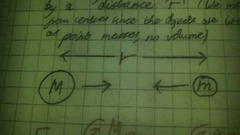
|
|
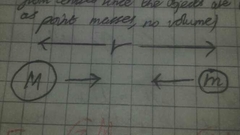
This is a gravitational field equation. What would the equation be for the force felt by two masses whose centres are separated by a distance 'r' ? State what each part of the eqaution means as well. This equation has a name. What is the name of this equation? |
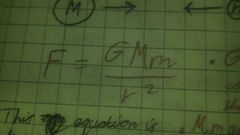
. G is gravitational constant (on formula sheet) . M, m are the masses . r is distance of centre separation The Name of this equation is 'Newton's law of gravitation'. |
|
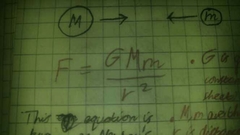
From this force equation for gravitational fields, what proportionalities can we get from the equation?
(Write them down in symbol terms and write down what they mean in words.) |
F oc Mm (The force between two bodies is directly proportional to the product of their masses)
F oc 1/r^2 (The force between two bodies is inversely proportional to the bodie's separation {distance between their centres})
|
|
|
Draw a situation of: 2 charges whose centres are separated by a distance 'r'. |
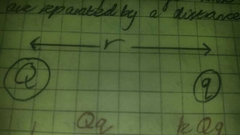
|
|
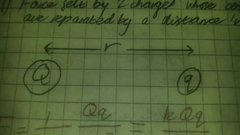
This force equation is for electric fields. What is the equation for the Force felt by 2 charges whose centres are separated by a distance 'r' ? (There are 2 versions of this force equation. Give both versions and state what each part of those equations mean.)
Which of these force equations is given in the formula book?
Which equation is the faster one, and should be used more often? Can I use either eqn? |
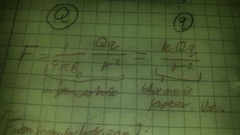
{Formula book eqn:} - Eo or (epsilon zero) - permittivity of free space (in formula book) - Q, q are the charges - 'r' is the distance of centre separation.
{From faster eqn:} - k or a constant I MUST REMEMBER k = 1/4(pi)(Eo) = 9 x 10^9 roughly.
I can use either eqn.
|
|
|
The 'k' that I have to remember, what part of the electric field force eqaution in the formula book is it equal to?
What is k equal to? (Thus, what is the expression which is that is part of the electric field force eqn in the book roughly equal to?)
Is this exact, or just a close enough approximation? |
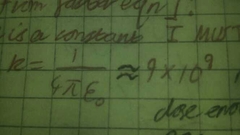
The 9 x 10^9 value is not exact, but it's a close enough approximation. |
|
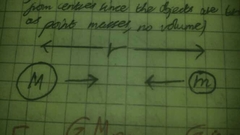
Gravitational fields: We will now tackle how to calculate the potential energy between the two masses whose centres are separated by a distance 'r'.
Explain how we would get from force to energy. (what is energy or work done equal to? How should we picture the situation? What should we imagine is happening? What do you multiply force {or the force equation} by to get to energy?)
What is the equation for the potential energy between the 2 masses whose centres are separated by a distance 'r'? |
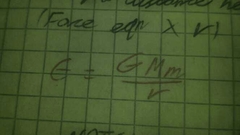
We know energy (work done) = F x d. In this case, imagine the two masses' centres were touching, and we want to separate them to a distance 'r' by putting in energy. We want the value of the energy.
Work done = Fr (r is distance here) ( Force eqn x r)
E is potential energy. |
|
|
The force from a gravitational field can only be... (attractive or repulsive?) |
Only attractive. |
|
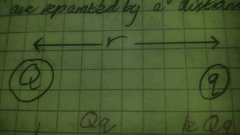
Electric fields: Explain how we would get from force to energy. (what is energy or work done equal to? How should we picture the situation? What should we imagine is happening? What do you multiply force {or the force equation} by to get to energy?) What is the equation for the potential energy between the 2 charges whose centres are separated by a distance 'r'? |
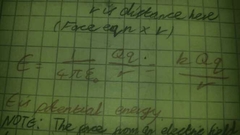
We know energy (work done) = F x d. In this case, imagine the two charges' centres were touching, and we want to separate them to a distance 'r' by putting in energy. We want the value of the energy.
Work done = Fr (r is distance here) ( Force eqn x r)
E is potential energy. |
|
|
The force from an electric field is... (attractive or repulsive?) |
It can be attractive or repulsive. |
|
|
Gravitational fields: Let's say we had one mass (E.g. a planet), M. Draw where it's field lines will go. |

|
|

Gravitational fields: Let's say we had one mass (E.g. a planet), M, with it's gravitational field lines going in. Let's say we just want to find how strong the field is (field strength) at any given point. Will we need 2 masses or 1 mass? What mass will we need? |
We will only need 1 mass, which is the mass producing the field to begin with. |
|
|
For gravitational and electric fields: Define Field Strength. |
Field Strength - "how much force an object would feel when in that field at a specific point/distance away from the centre of the mass." |
|
|
Gravitational field: How would you go from force (eqn) to field strength (eqn)? What is the purpose of this step to get from force to field strength? What is the equation for gravitational field strength? What is the unit of gravitational field strengh? |
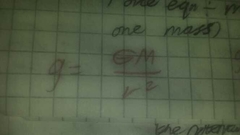
Force equation ÷ m (The purpose of this step is to get rid of one mass) g = graviatational field strength (unit is N/kg) |
|
|
Let's say we had one charge, a proton, Q. Draw the proton and it's field lines in the correct direction. |

|
|
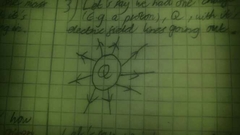
Electric fields: Let's say we had one charge, a proton, Q with it's electric field lines going out. If we want to find how how strong the electric field is at any given point, How many charges do we need? What charge will we need? How would you go from force to electric field strength? What is the purpose of this step? What is the equation for electric field strength? Give the units and symbol of electric field strength. What is the equation for electric field strength? Give the units and symbol of electric field strength. |
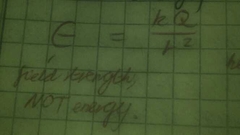
We will only need one charge, which is the charge producing the field to begin with. To go from force to electric field strength, Force eqn ÷ q (to get rid of one charge) E here is electric field strength (NOT ENERGY). Unit is N/C. |
|
|
a) Field Strength involves how many masses/charges? b) What is the mass/charge doing? c) What does field strength tell us? |
a) Only involves 1 mass or 1 charge b) the mass/charge is producing the field to begin with. c) Field Strength tells us how much force per kg or force per coulomb something would feel if it's centre and M or Q's centre were 'r' metres away from each other. (depending on whether it's a gravitational field or electric field). |
|
|
How do you calculate escape velocity? |
Make kinetic energy = gravitational force, solve for v. |
|
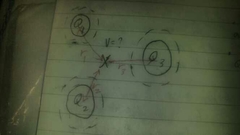
Lets say we have 3 + ve charges producing their own electric fields.
They all have their own equipotentials. If we know r1 r2 and r3 (or can work them out using trig), How would you find the overall potential at X? |
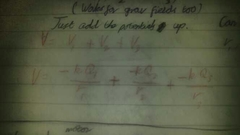
Just add the potentials up. |
|
|
The time period and radius of a satellite in orbit are related. For satellites, there is a centripetal force acting on them. What is the centripetal force in the case of satellites? So what two things can we make equal in this case? |
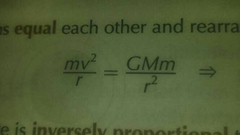
Gravitational force. |
|
|
We can treat a satellite in orbit like circular motion. Explain how you would find the time period of the satellite. |
1) make the centripetal force equal gravitational force 2) solve for v 3) equate to 'v' in circular motion (2 x pi x r/T) 4) solve for T. Done! |
|
|
What is the relationship between T and r? |
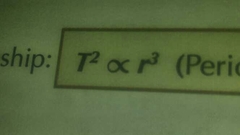
After deriving eqn for time period. |
|
|
What is a geostationary orbit? How long does it take? What is its orbital radius? Why are these useful for tv and telephone signals? |
Orbit where the satellite is always directly above the equator. And orbits at the same speed as the earths rotation. It takes one day Has an orbital radius of about 42000km Useful for tv and phone signals since they stay at the same point above the earth, so you don't need to alter the angle of the receiver. |
|
|
What are low orbit satellites? Why are they useful? What are they used for? What is bad about them? |
Satellites between 180-2000 km above earth. They are cheaper, Used for communications. They arent good because you need multiple satellites to maintain constant communication signals. |
|
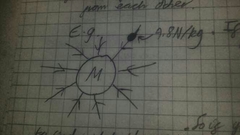
Look at the diagram. If the gravitational field strength at where the arrow is pointing was 9.8N/kg, if we were to put a mass of m kg at that point, how much force would that mass feel overall? E.g. if the mass was 2kg, how much force would it feel? |
9.8 x m N E.g. mass 2kg, Force = 19.8 N |
|
|
If you have a field strength, and you want to find what the actual force is acting on the charge/mass, how do you do it? |
Field Strength x 2nd charge / mass. |
|
|
Define Gravitational Potential. Define Electric Potential. |
Gravitational Potential - the amount of energy required by a 1kg mass to move from infinity to that point ('r' metres away from the other mass's centre producing the field.) Electric Potential - the amount of energy required by a 1C charge to move from infinity to that point ('r' metres away from the other charge's centre producing the field.) |
|
|
How do you get to the 'potential' eqn for: Gravitational Potential Electric Potential? |
Gravitational Potential - Graviatational potential energy eqn ÷ m (x -1) Electric Potential - Electric Potential energy eqn ÷ q (× -1) |
|
|
What is the equation for gravitational potential? What are the units? |
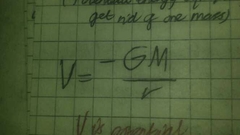
Unit is J/kg |
|
|
What is the equation for Electric Potential? What are the units? |
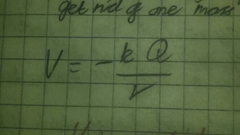
Unit is J/C |
|
|
Is electric potential and gravitational potential similar to potential difference in electricity? |
Yes. They are the same thing (apparently) |
|
|
Why is there a minus in the.equation for gravitational potential and electric potential? |
Because for a gravitational or electric field, energy needs to be put in to move something further away. So to move something closer, energy must be released (E<), so potential will be -ve. |
|
|
Equipotentials can be drawn around an object producing some sort of field. Define Equipotential. |
Lines around a gravitational or electric field where any point on the line will have the same potential. |
|
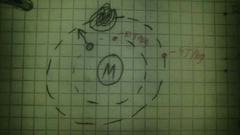
This is an example of Equipotentials in a gravitational field. 1) What happens to your potential as you move from one equipotential to another? E.g. from -10J/kg to -4J/2kg ? 2) potential x mass = what? 3) so change in potential x mass moving from Equipotentials = what? 4) does this all apply to charges as well? |
1) Your potential changes. Change in potential = 6J/kg. 2) potential x mass = energy 3) change in potentials x mass = energy needed to do that jump. 4) this all applies to charges as well. |
|
|
How would you go from potential to field strength? (same for both gravitational and electric eqns) So what is another equation we can use for gravitational field strength because of this fact? When can we use this equation for gravitational field strength? |
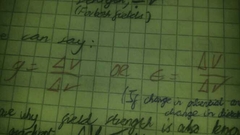
Potential ÷ r We can use this equation for gravitational field strength when change in potential is given. |
|
|
These equations for field steength are also known as what? |

Potential gradients (like gradient for a straight line) |
|
|
You may be given a graph of potential against distance (V on y axis, r on x axis). What does it generally look like? What is the gradient of this graph equal to? Is this graph the same for electric and gravitational fields? |
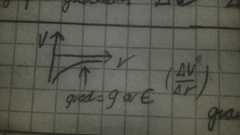
Note: you must use tangential gradients. E.g. tangential gradient at r metres = field strength at r. Its the same for gravitational and electric fields. |
|
|
You may be given a graph of field strength against r (distance). Draw what it looks like generally. What is the area under the graph equal to? |
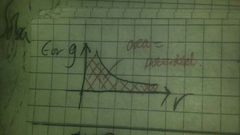
Area under graph gives potential (V) |
|
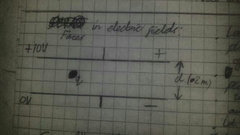
Forces can act in electric fields.
Let's say we have two parallel plates attached to something providing a PD of 10V.
There will be a voltage (PD) inbetween the plates.
If we put a charge between the plates, and we want to know what force the charge would feel,
What is the equation we would use?
Explain how we would get each component of the equation. This equation only works in one situation. Which is what? |

We would use F = Eq
Force = field strength x charge
Charge of particle will be given.
We know from before: Field strength = change in V / Change in r.
V change = 10 V
r change = 2 m
Sub each component in then DONE! Only works when there are 2 parallel plates. |
|
|
Draw how gravitational field strength varies with distance from a planet's centre. Explain what is happening at each part of the graph. And why. What is the field strength at the planets centre? |
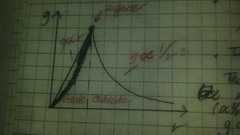
At 1st part (straight line), inside the planet, g oc r because field strength varies with r^2, but the planet has a volume proportional to r^3. And r^3 x 1/r^2 = r Outside the planet, g oc 1/r^2. Field strength at centre = 0 since we have mass pullinng in all Directions. |
|
|
You can have a resultant force (F) and resultant field strength (g or E) , sso in some situations, F and (g or E) can equal zero. This is needed for the next step. |
Ok. |
|
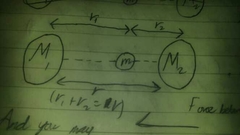
Lets say we have two masses, M1 and M2, and another mass m between them. If the mass is still, what can we say about force and gravitational field strength? If we were asked to find r1 and r2, and we know r, and everything else, how would we do it? |
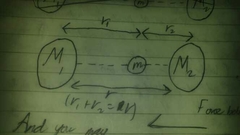
F1 = F2 (Force between M1 and m = Force between m and M2) g1 = g2 (grav field strengths equal as well) To find r1 and r2: r1 + r2 = r And (GMm/r1^2) = (GMm/r2^2) Simul solve. |
|
|
If 2 masses are touching, the distance 'r' between them is... If they are then separated by a given distance x, then the new distance 'r' between them is... |
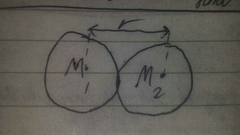
Their radii added together. New distance = sum of radii + x |
|
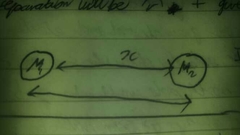
If you are given the separation of their surfaces, x, the distance between the masses is... |
x + sum of their radii. |
|
|
What can potential NEVER be? At what point can potential be this thing? For what kinds of fields is this always true? For the other field type, when is this true and explain a situation where it may not be true. |
Potential CANNOT be ZERO! (only at infinity) Always true for grav fields. Only true for electric fields if theres only 1 charge type present. (only +ve or -ve charge) E.g. Potential will be 0 halfway between a proton and electron since the potentials will cancel as one is +ve (electron) and one is -ve (proton) and they are the same magnitude. |

